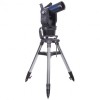Meade ETX-90 User Manual - Page 51
Equatorial Mount - owners manual
 |
View all Meade ETX-90 manuals
Add to My Manuals
Save this manual to your list of manuals |
Page 51 highlights
viewed through a telescope such as an ETX, this motion is rapid indeed. If the motor drive has not been engaged, celestial objects viewed in the telescope eyepiece drift entirely out of the field of view in 15 to 60 seconds, depending on the magnification employed. However, by mounting your telescope and turning on the motor drive, you can counteract the drift of objects in the eyepiece. The two basic types of mounting are: altazimuth (alt/az) and equatorial. For many ETX owners, it will not be necessary to equatorially mount the telescope; alt/az mounting will suffice. The AutoStar Controller allows the telescope to be mounted in the altazimuth (alt/az) mode for most observing purposes. See Easy (TWO-STAR) Align, page 11, for more information. However, owners who wish to perform astrophotography will find equatorial mounting indispensable to their needs. Equatorial Mount Equatorial mounting lines up the telescope's polar axis with the North Celestial Pole (or the South Celestial Pole if observing in the southern hemisphere). When using an equatorially mounted telescope, tracking (following) celestial objects is possible by turning on your ETX telescope's motor drive. The motor counteracts the Earth's rotation and keeps objects in the field of view of the eyepiece for hands-off tracking. Equatorial Mounting Procedure 1. Assemble the tripod as described in Step #2 of Getting Started on page 5. 2. Loosen the latitude control latch (Fig. 19) and lift up the tilt-plate so that you can easily access the underside of the plate. Relock the latitude control latch, so the assembly doesn't slip while you are attaching the telescope. 3. Turn the tripod, so that the face of the tilt-plate points North (Figs. 20). If you attach the telescope to the tripod indoors, be sure to orient the face of the tilt-plate to point North after moving the telescope outdoors. Equivalently, point the tripod leg (Fig. 20) North. This is the leg opposite from the latitude control bar (Fig. 18) . 4. Line up the mounting hole on the base of the telescope so the computer control panel faces westward. Thread both attachment knobs into the base of the telescope. Tighten to "firm-feel" Latitude control bar Figure 18: Attach Telescope to Tripod Tighten to a firm-feel only. 5. Determine the latitude of your observing location from a road map, atlas or the Latitude Chart for Major Cities of the World, page 54. Loosen the latitude control latch (Fig. 19) and adjust the latitude control bar (Fig. 18) so that your observing site's latitude is just visible above the flat surface of the tripod head. Retighten the latch. Latitude control latch Figure 19: Set latitude 6. If you have not already done so orient the tripod leg (Fig. 20) so that it is pointing due North (if the location of Polaris, the North Star, is known, point the telescope directly at Polaris. Observers located in the Earth's Southern Hemisphere must point the telescope due South). 7. The telescope is now equatorially mounted; the tripod must not be moved or else the alignment will be lost. Instead, use one of the following methods to move the telescope's optical tube to a desired celestial object. (a) Loosen the vertical and/or horizontal locks (Pg 13, Fig. 3, 6 and 9) to permit the optical tube to be freely moved manually. Tighten the locks once you center on the object. (b) With the horizontal and vertical locks in their EQUATORIAL ALIGNMENT 51















